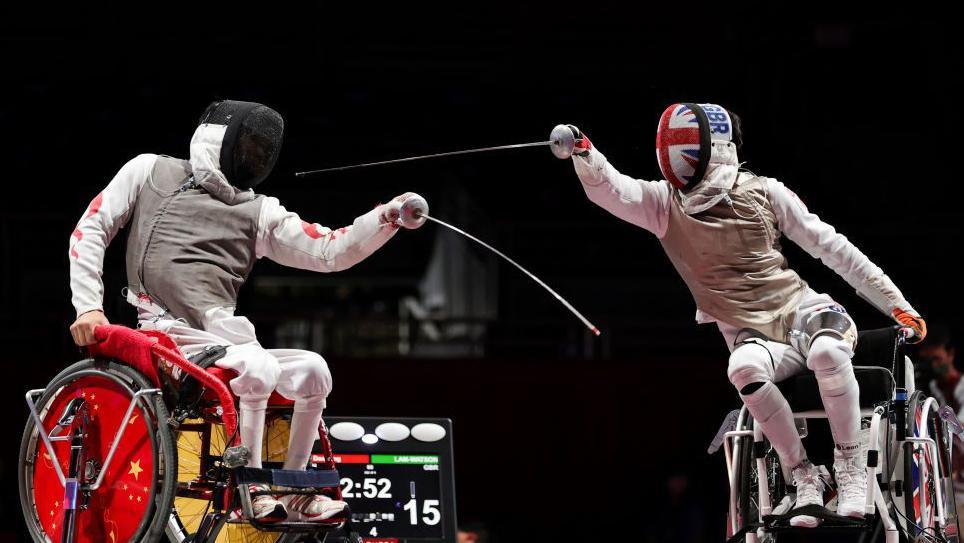Paralympics 2024: A guide to wheelchair fencing at the Paris Games

Wheelchair fencing bouts are fast, furious and intense
- Published
Key information
Dates: 3-7 September
Venue: Grand Palais
Gold medals on offer: 16
What are the rules of wheelchair fencing?
There are three disciplines in wheelchair fencing based on the type of sword used - the foil, the epee and the sabre.
The epee is the heaviest weapon at 770g and is more rigid than the other swords, the foil is lighter and highly flexible while the sabre has a short, flexible blade.
In the foil event, fencers are only permitted to strike the trunk area of the opponent, while in the sabre and epee, anywhere above the waist is a valid target area.
Hits are recorded by striking an opponent cleanly in the valid area, with successful hits recorded by the electronic equipment.
Fencers wear metal aprons to ensure that hits to off-target areas are not counted.
During a contest, the fencers' wheelchairs are fastened into metal frames on the floor at an angle of 110 degrees. This allows freedom of the upper body only and allows the fencers' sword arms to oppose each other. The distance between the fencers is dependent on the fighter with the shorter arm reach.
Bouts last a maximum of three minutes in the preliminary pool stages of the competition, with victory going to the first fencer to score five valid hits or the one with the most hits at the end of the three minutes.
The preliminary round results form the seedings for the knockout stages. Here, bouts consist of three rounds of three minutes. The winner is the first to score 15 hits, or the highest scorer at the completion of the contest. In the event of a tie, an extra one-minute sudden death bout is held, with the first person to score a valid hit taking the contest.
In team events, teams are made up of three fencers. Each fencer faces each opponent in the other team in a single bout of three minutes. The winning team is the one with the most points when the time is up, or the first to reach a cumulative score of 45 points.
Classification divisions are based on impairment. Category A fencers have good trunk control, whereas Category B athletes have an impairment that impacts their trunk or their fencing arm.
Which athletes are competing for GB in Paris?
Piers Gilliver and Dimitri Coutya will both be hoping to add to their Paralympic medal haul.
Gilliver's victory in the Epee A event in Tokyo gave GB their first gold medal in the sport since 1988 and he goes into Paris as world and European champion.
Coutya, who won two individual bronzes three years ago, is a challenger in the Epee B and Foil B events where he is European champion and world medallist and will be hoping to improve on his Tokyo performance.
Gilliver and Coutya will combine with Oliver Lam-Watson as GB chase team medals while Gemma Collis has a chance of a medal in the women's epee A event.
Who are the other medal challengers?
China won 11 of the 16 gold medals on offer at Tokyo 2020 with Tan Shumei leading the charge with three (two individual and one team) and they were dominant again at last year's World Championships in Italy.
Italy's Beatrice (Bebe) Vio Grandis, one of the stars of the Rising Phoenix documentary, returned from two years out to win gold in the Foil B event and will be hoping to retain her Paralympic crown.
Elsewhere, France's Maxime Valet (Foil B) and Poland's Adrian Castro (Sabre B) will be among those hoping to stop the Chinese dominance.
Did you know?
Thailand's Saysunee Jana created sporting history at the Athens Paralympics in 2004 when she became her nation's first female gold medallist when she triumphed in the Epee B event.
Since then, she has gone on to win a medal at each subsequent Games - another gold at London 2012, silver in Rio and bronze in Beijing and Tokyo - and she will be aiming to keep up that medal record in Paris.
ParalympicsGB Tokyo 2020 medals
Five - one gold (Piers Gilliver), one silver (team foil) and three bronze (Dimitri Coutya x 2, team epee)